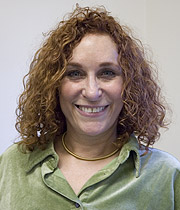Berkeleyan
What looks like a wetsuit and saves lives?
![]()
| 22 March 2006
Many women in developing nations dread discovering that they're pregnant - or pregnant again, says Suellen Miller, an assistant adjunct professor in the School of Public Health. "Death is a part of pregnancy and childbirth in those places," she observes.
 Suellen Miller (Wendy Edelstein photo) |
A garment that resembles the bottom half of a wetsuit may increase the survival chances for women with obstetrical hemorrhage, the cause of 60 percent of maternal deaths in developing countries. (Obstetrical hemorrhage subsumes not only postpartum hemorrhaging but other forms of pregnancy-related bleeding, such as from abortion and ectopic pregnancy.) Miller, a certified nurse midwife with a Ph.D. in family-healthcare nursing from UCSF, has done extensive global research on maternal health. In her role as director of the Safe Motherhood Programs of the UCSF Women's Global Health Imperative, she directed a study that evaluated the use of a non-pneumatic anti-shock garment (NASG) in treating post-partum hemorrhaging (PPH), the findings of which will be published in the April issue of the British Journal of Obstetrics and Gynecology.
Surviving the long wait for care
First developed for use in space, the garment was modified by a NASA physiologist so it would no longer have to be inflated with a large foot pump. Paul Hensleigh, a Stanford University emeritus professor in obstetrics and gynecology, took the modified garment to Pakistan for use on patients who were bleeding and experiencing long delays before they could receive blood transfusions. Miller read Hensleigh's case study about his work in Pakistan and thought the garment might be useful in developing countries, "where women often die in childbirth because they don't have enough time to get to distant hospitals."
The garment, which consists of five connected segments, is made from neoprene, a synthetic rubber also used in wetsuits, and closes with Velcro. Four of the sections close tightly over the calf, thigh, and pelvic areas, while the fifth is secured over the abdomen. An attached compression ball presses on the uterus and the midsection, an area with many blood vessels. "By putting pressure on the outside of the blood vessels, you decrease their radius," Miller explains, with the result that the flow of blood is slowed.
The NASG is "so simple, it takes no time to teach someone how to put it on," says Miller. The garment, which costs about $160, can be bleached and washed after each use and reused up to 40 times.
The pilot study, conducted at four teaching hospitals in Egypt, tracked 364 obstetrical-hemorrhage patients, 158 of whom underwent standard hemorrhage treatment, which sometimes involves drugs such as oxytocin and misoprostol to stop PPH when the uterus fails to contract after delivery. Another 206 women who received the same treatment were also placed in the NASG. Women at any stage of pregnancy were included in the study if they were in clinical shock from obstetrical hemorrhaging and had at least a heartbeat upon arriving at the hospital. A plastic blood-collection drape was placed beneath participants to collect and measure their blood loss. The study showed dramatic results: a statistically significant 50 percent decrease in median blood loss for the women whose obstetrical hemorrhaging was treated both with standard measures and the NASG.
A second set of trials took place in Nigeria, where Miller's colleagues were amazed, even stunned, by the results. "These doctors are so used to being helpless," says Miller, who notes that pregnant women in deep shock are often ferried to hospitals where there are no blood supplies or IV fluids. The doctors receiving these patients assume they will die - an assumption that Miller says is often shared by the women's relatives, who see their family member looking completely pale and lifeless, occasionally gasping for breath. Not all of the women who hemorrhage do die, says Miller: Many of them survive, albeit with organ damage or other impacts that can negatively affect their longevity and physical activity.
The NASG's next round of trials will monitor morbidity and mortality rates of women with obstetrical hemorrhaging in Egypt and Nigeria. While Miller anticipates that these studies will provide strong evidence that the NASG saves lives, at least a five-year multi-country randomized clinical trial will likely be required before it is approved for widespread global use.

